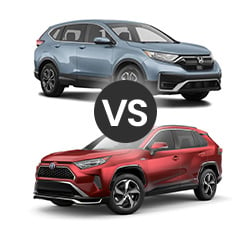2021 Honda CR-V vs Toyota RAV4
Hondas and Toyotas have been long-standing fixtures on the roads, with their CR-Vs and RAV4s remaining some of the top contenders in SUV class. Whether you're zooming down highways or winding through backroads, chances are one of these reliable vehicles will be close at hand!
For drivers looking for a dependable two-row SUV, the selection of options can be overwhelming - luckily there are models like these that combine affordability and luxury to make every decision easy. These vehicles come in different trims so they appeal to budget savvy customers as well as those seeking top notch features, while guaranteeing their occupants ample interior space and steadfast reliability with improved safety ratings. This guide breaks down how exactly they differ from one another so you find your perfect match!
The Powertrain
Going hybrid has never been more appealing. Honda and Toyota's newest models boast the same levels of power as their conventional brothers, while also giving eco-minded drivers an alternative that doesn't compromise on performance. Hybrid technology is no longer just a greener way to drive - it can now deliver thrills too.
Honda's latest CR-V lineup boasts four trims: LX, EX, EX-L and Touring. Under the hoods of these dynamically styled SUVs rests an efficient 1.5-liter turbocharged engine combining for 190 horsepower and 179 pound feet of torque - perfect power to take you on your next adventure! If that isn't enough oomph, upgrade to one of their hybrid models which supplies a further potent 2.0 liter four cylinder plus electric motor combo providing 212 total horses.
The Honda CR-V is an excellent choice for drivers who enjoy fuel efficiency. With a traditional engine, you can achieve up to 28 miles per gallon in the city and 34 on the highway, making for an economical commute or road trip. But if outstanding gas mileage is your priority, try out its hybrid counterpart--it boasts 40 mpg in cities and 35 on highways.
With Toyota's RAV4, you can expect top-notch performance and excellent fuel economy. Its robust 2.5-liter engine churns out a powerful 203 horsepower and 184 pound-feet of torque to ensure remarkable acceleration. And with an impressive 35 miles per gallon on the highway (28 in town), your wallet will thank you for choosing this SUV option when it comes time for gassing up.
With a hybrid system in place, the RAV4 would still have a 2.5-liter engine. Because it has the boost from an electric motor, it has 219 total horsepower. The hybrid RAV4 does even better than the hybrid CR-V does. A RAV4 with the electric motor gets 41 miles per gallon in the city and 38 miles per gallon on the highway.
The Honda uses a continuously variable transmission, and drivers can choose Sport mode if they ever want their vehicles to be a little more aggressive. The Idle-Stop function helps to save fuel since it turns off the engine if the vehicle has been stopped for more than a few seconds. Likewise, the Eco Assist System can be useful if someone wants to conserve energy. The top three trims of the CR-V have a convenient remote engine start feature, and all trims have Hill Start Assist so they can hold the brakes when stopped on a hill.
Select trims of the Toyota RAV4 have something similar to Idle-Stop. Toyota calls its program the Stop and Start Engine System. All trims have Hill Start Assist Control, and some have Downhill Assist Control to limit speed when traveling down steep slopes. In a RAV4, there's a drive mode dial that people can use if they ever want to switch from the Normal drive mode. The other options are Sport and Eco. This is very similar to what the Honda CR-V has. Plus, many RAV4 models have remote start.
For total control, Toyota's cutting-edge hybrid powertrain comes complete with a Direct Shift Electronic Transmission and an 8-speed sequential shift mode. For those seeking increased efficiency while maintaining the feel of manual transmission, they also offer their innovative continuously variable electronic transmission paired with its own sequentially shifting capability - all part of effort to give you supreme performance behind the wheel.
The RAV4 and CR-V offer the choice of either front-wheel or all-wheel drive to meet consumers' individual needs. The CR-V's base trims have standard front wheel capability, but an upgrade is available for those who seek greater performance in formidable conditions. All hybrid trim models are equipped with reliable all wheel power at no extra cost.
Toyota has taken a revolutionary step into the future with its hybrid technology. All hybrids now come equipped with an electronically-controlled, all-wheel drive system and five unique driving modes—Sport, Eco, Normal EV and Trail—to give drivers maximum performance capability while still capitalizing on fuel efficiency.
Appealing to adventure-seekers everywhere, the RAV4 is equipped for extreme conditions with standard all-wheel drive on two of its trims. The TRD Off Road model steps it up a notch further with a TRD suspension system and dynamic torque vectoring technology while other available trim levels offer Multi Terrain Select dials enabling drivers to adjust them in Normal, Snow, Rock & Dirt or even Mud & Sand. With these features combined, you can confidently take your ride off the beaten path when needed.
With the non-hybrid RAV4 and CR-V offering a robust 1,500 lbs. of towing capacity, those seeking even more versatility will appreciate that hybrid models can take up an extra 250 pounds for total capability of 1,750 lbs. - perfect for light trailer use.
Drivability
The power of the RAV4 makes it an invigorating experience for those behind the wheel, especially when equipped with advanced features like XSE or TRD Off-Road. However, don't be fooled - The CR-V is still a exhilarating drive and scarcely lacks in any category compared to its competitor.
The Honda CR-V and Toyota RAV4 offer simple parking solutions to drivers in a variety of sizes. While the length between them is minimal, with the CR-V at just 1.2" longer than its counterpart, they both possess identical widths - making for an easy fit into tight spaces. An ever so slight difference exists when comparing their heights however; as the RAV 4 comes up 0.8 inches shorter overall than that of the CRV's height span.
The RAV4 stands above the competition when it comes to clearance; with 8.4 inches of ground space, this vehicle will keep you going over all kinds of terrain - even more so than a front-wheel drive CRV at 7.8'', and an AWD version at 8.2''. Don't let rocky roads stop your adventure.
With 3.6 extra inches of room in the rear, the CR-V offers a comforting level of spaciousness for passengers compared to its rival, the RAV4. Not only that - both cars provide ample legroom up front with almost identical measurements of 41inches each. When it comes to interior space and comfortability on long journeys however, there's no doubt: The larger CR-Vs reigns supreme.
Prospective shoppers can rest assured that the Honda CR-V and Toyota RAV4 offer plenty of cargo capacity to meet their needs. When its rear seats are folded down, the CR-V offers up to 75.8 cubic feet of space while the RAV4 has 69.8 cubic feet - both enough for everyday life's larger items or a weekend getaway with family and friends! For more immediate storage demands, when upright each model provides ample volume; 39.2 CF in the Honda compared to 37.6 CF in Toyota's cabin nook make short trips seamless too.
Featuring the ultimate in convenience, both models of the Honda CR-V boast an array of advanced tech components. The top trim is especially impressive with its navigation system, HD Digital Traffic and a premium audio setup comprised of nine speakers for superior sound quality. Additionally, it offers all other trims standard features such as a seven-inch touchscreen display featuring smartphone compatibility, Bluetooth connectivity plus SiriusXM and HD Radio support powered by four total USB ports for maximum versatility.
The top trim of the Toyota RAV4 is the Limited Hybrid. It has a larger touchscreen that measures eight inches, whereas many of the other trims have seven-inch touchscreens. The Limited Hybrid's infotainment system comes with navigation, 11 JBL speakers, five total USB ports, Bluetooth, smartphone compatibility, and SiriusXM. Wi-Fi capability is available. Every trim of the Toyota RAV4 has Amazon Alexa to make it so easy to look up different kinds of information, just like some may be accustomed to doing with their home devices.
The RAV4 starts out with a seven-inch touchscreen, six speakers, Bluetooth, smartphone compatibility, SiriusXM, and as mentioned above, Amazon Alexa. This is a contrast to what the entry-level LX trim of the CR-V has. It has Bluetooth and Pandora compatibility, but it only has a five-inch LCD screen and four speakers. However, the middle trims of the CR-V have comparable offerings to the infotainment packages on the RAV4.
To avoid overpaying on a new car, shop prices online first. Get up front pricing before you walk into a dealership. We recommend the following free services; Car Clearance Deals, NADAguides, CarsDirect & & Motortrend.
These free services will offer you the lowest prices and supply you with multiple competing price quotes. You will know the best price before you visit the dealer.
Safety
SUVs are the gold standard in safety, and these two models stand far above the rest. Equipped with all of the must-have features like LATCH systems, air bags galore, daylight running lights and rearview cameras - plus driver-assist technologies that provide a second set of eyes on hazards or potential problems before they become dangerous – it's clear why these SUV models have earned such high esteem from our Safety Department.
In the Honda CR-V, every trim can warn drivers about potential frontal collisions and when they're veering out of their positions. The SUVs can then apply pressure to the brakes or correct steering, if appropriate. The CR-V also has adaptive cruise control and automatic high beams as standard elements, and most models have blind-spot and rear cross-traffic monitoring.
The Toyota RAV4 is equipped with the cutting-edge safety package, Toyota Safety Sense 2.0 – on par with that of Honda's CR-V. Not only does it have features such as frontal collision warnings and lane drifting alerts, but also delivers superior driving experience through adaptive cruise control and automatic high beams for added security; all trims come standard with blind spot monitoring and rear cross traffic alert too!
The RAV4 provides drivers with a range of additional features to make their journeys smoother. Road Sign Assist allows for the reading and displaying of road signs directly on the vehicle's dashboard, giving greater visibility and awareness in navigating routes. Select models include a bird’s-eye-view camera system providing unparalleled accuracy when battling tight spaces or low speed maneuvering along roadsides. To top it off, an available parking assist technology can be utilized - featuring precision steering control as well as automatic braking capabilities!
Which Has the Best Value?
For a few thousand dollars, you can have the reliable CR-V or its smart and powerful RAV4 counterpart. The LX trim of the Honda CR-V starts at $25,350 while Toyota's entry-level LE trim is available for just over $26k. Hybrid powertrains between both vehicles cost around an additional 2 - 3k; opting for all wheel drive may add more to your total sum depending on which model interests you most!
With eleven total RAV4 trims and 4 (or 7 when accounting for hybrid options) CR-V trims, the marketplace is wide open. Looking at the top level of both vehicles provides a stark contrast: The Hybrid Touring trim on the CR-V has an MSRP of $36,350 while the Limited Hybrid option in Toyota’s RAV4 lineup carries a price tag of $37,330. In between those two extremes lies more than just pricing differences - midlevel models feature greater power capabilities along with additional technologies that further distinguish these competitors.
The exterior of the two vehicles shares some common features, such as LED headlights and fog lights. However, where they begin to differ lies in their customization options; with an available two-tone look exclusive to the RAV4 plus more chances for personalization courtesy of optional chrome or black details.
The RAV4 and CR-V provide drivers with an equal level of comfort inside their respective cabins. However, tech features such as heated front seats, push button start system and more are available for a personalized experience in the RAV4 - including SofTex upholstery on higher trims! The CR-V provides leather accents to its EX-L and Touring packages' interiors while offering a heated steering wheel option that can be added onto select models.
Which is Better?
The RAV4 and CR-V offer a balanced combination of power, comfort, sophistication and convenience. Not only do they possess plenty of cargo space for all your gear but also feature comfortable seating along with the latest in sophisticated technology to keep you on top of the game.
When considering a new SUV, the differences between Toyota's RAV4 and Honda's CR-V may not be immediately obvious. However, taking an in-depth look reveals that each model has unique qualities to offer potential owners. The RAV4 offers enhanced durability with its rugged design and power capabilities along with superior safety features compared to the more spacious interior of the stylishly appointed CR-V featuring leather seating. Both vehicles have merits worth examining when selecting your perfect fit.

Get up to 4 local dealers to compete for your business by offering free, competitive pricing. Know before you go to the dealer.
Every dealer offers a secret price. Find yours here.
• 2021 Honda CR-V VS Acura RDX
• 2021 Honda CR-V VS Ford Edge
• 2021 Honda CR-V VS Ford Escape
• 2021 Honda CR-V VS Kia Sportage
• 2021 Honda CR-V VS Nissan Rogue
• 2021 Honda CR-V VS Subaru Crosstrek
• 2021 Honda CR-V VS Toyota RAV4


